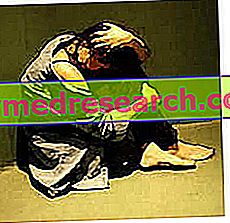Generality
Dysthymia is a mood disorder that, due to the symptoms it causes, looks a lot like depression.

Dysthymia is also known as dysthymic disorder, persistent depressive disorder or neurotic depression .
The precise triggering causes are unknown; life experiences that are difficult and dramatic play a key role.
The diagnosis of dysthymia requires several diagnostic tests, including an accurate psychological assessment and careful physical examination.
To be able to heal, we need: adequate psychotherapy, antidepressant-based drug therapy and, finally, considerable collaboration on the part of the patient.
What is dysthymia?
Dysthymia is a mood disorder similar to depression, but of lower severity and with a tendency to last over time
The dysthymic patient, in fact, shows the same symptoms as depressed people, but in a milder and often longer lasting form.
Despite the lower severity, dysthymia is considered a chronic problem, where chronic means that the symptoms recur every day (except momentary interruptions) for a certain period of time (in this case, at least two years). Depression, on the other hand, manifests itself with much more serious symptoms, but which resolve itself over a shorter period of time, to then eventually reappear. Suffice it to say that, for the diagnosis of depression, the persistence of a severely depressed mood is required for at least two weeks.
SYMPTOMS OF DEPRESSION
What are the classic symptoms of depressed people ?
People affected by depression feel downhill, sad, empty, hopeless, worried, helpless, guilty, irritated, restless and offended; moreover, they feel aversion to any activity, suffer from loneliness, insomnia, hypersomnia, digestive problems, drops in energy, lack of appetite or excessive appetite and suicidal delusions.
The expressions of depression, therefore, are numerous and sometimes very different from each other.
POSITION IN THE DIAGNOSTIC AND STATISTICAL MANUAL OF MENTAL DISORDERS (DSM)
The Diagnostic and Statistical Manual of Mental Disorders (DSM) is a collection of all the peculiar characteristics of known mental and mental illnesses, including the respective criteria required for diagnosis.
Until 2013, dysthymia was treated as a mood disorder other than depression, albeit with some analogy.
In the last edition, released in 2013, instead, the dysthymic disorder was included in the chapter dedicated to depression, as if it were a sub-type of the latter. The reason for the change is related to the similarity and overlap of the most characteristic symptoms.
Epidemiology
According to some statistical studies concerning the entire globe, dysthymia affects about 105 million people (or 1.5% of the world population) every year.
It may concern individuals of any age, including children. Women are the subjects who get sick most frequently.
ORIGIN OF THE NAME
The term "dysthymia" was coined, in 1970, by Dr. Robert Spitzer and took the place of "depressive personality", used previously. Today, the disorder is also known as neurotic depression or dysthymic disorder, although recently the DSM-5 (2013) introduced the new term Persistent Depressive Disorder ( persistent depressive disorder ).
Causes
The causes of the onset of dysthymia are unclear. According to the researchers, factors of a biological, genetic and environmental nature influence.
Biological factors
Some scientists believe that the brains of dysthymic people undergo decisive neurological changes (for example the lack or poor activity of some neurotransmitters, such as serotonin). However, research in this direction still contains question marks, as some people with dysthymia do not show any alteration of brain activity (ie, from a neurological point of view, they are completely the same as healthy people, not affected by dysthymia).
Genetic factors
The idea of a genetic component, at the base of dysthymia, stems from the fact that often affected people have blood relatives (parents or siblings) who are sick with the same mood disorder or depression. Genetic theory is interesting, but it needs to be investigated.
Environmental factors
Like depression, dysthymia is also strongly linked to difficult life situations, to the loss of a loved one, to economic problems, to high stress conditions, to the onset of particular health problems that have influenced the existence of the individual sick etc.
FAVORABLE CIRCUMSTANCES
Dysthymia has been found more often between:
- People who live or spend a lot of their lives with dysthymic or depressed people.
- Individuals who have experienced stressful / dramatic moments of life, such as the loss of a loved one or having serious financial problems.
- The subjects who, due to their character, need continuous reassurance and approval from others.
Symptoms and Complications
To learn more: Dysthymia symptoms
The main symptoms of dysthymia, in adults, are: loss of interest in any daily activity or hobby, sadness, low morale, hopelessness, tiredness, lack of energy, low self-esteem, feeling inadequate, difficulty concentrating and of decision, irritability, sleep disorders ( insomnia or hypersomnia ), pessimistic view of life, lack of appetite or excessive appetite, guilt and repudiation for any social activity.
IN THE CHILD

The classic pathological expressions of the dysthymic child are:
- Irritability
- Behavioral problems
- Poor academic performance
- Pessimistic view
- Asociality and a tendency towards solitude
- Low self-esteem
CHARACTERS AND DURATION OF SYMPTOMS
Dysthymia is a chronic mood disorder, in the sense that it reappears, with its symptoms, every day for a specific period of time.
The pathological expressions can vary in terms of intensity: in some periods, the patient is particularly suffering, while in others it may seem cured even if it is not (these moments are commonly called " the ups and downs " of the disease).
According to the Diagnostic and Statistical Manual of Mental Disorders (DSM), dysthymia, to be considered as such, must have a minimum duration of 2 years in adults (NB: in the 2 years the so-called ups and downs are included)
WHEN TO REFER TO THE DOCTOR?
Feeling temporarily down in the dumps because, for example, a dramatic event has occurred, it is normal and should not be confused by dysthymia or some other mood disorder.
However, when this sensation, or others of the same kind, last for some time and interfere with social life and work activities, it is best to contact your doctor (or a psychotherapist ) to request a consultation / comparison.
Often, people with dysthymia or other mood disorders are ashamed of their situation and struggle to turn to someone for help; this, however, is completely wrong and risks isolating the sick person even more.
COMPLICATIONS
Dysthymia can lead to various complications, some of them very serious.
In fact, besides reducing the quality of life, it can also cause the following complications:
- Depression proper
- Use and abuse of toxic substances
- Difficult family relationships
- Social isolation
- Work or school problems
- Total inactivity
- Anxiety
- Food disorders
- Suicidal tendencies
Diagnosis
A patient with suspected dysthymia is usually subjected to an objective examination, laboratory tests and a psychological evaluation.
Physical examination and laboratory tests are necessary for the doctor to understand if there may be a link between mood disorders, complained of by the patient, and the general state of health.
Psychological evaluation, on the other hand, is fundamental to establish the real characteristics of the mental illness in progress and to understand whether it is actually dysthymia or not.
EXAMINATION OBJECTIVE
During the physical examination, the doctor (in this case, it does not have to be an expert in mental illnesses) investigates whether the patient suffers (or suffered in the past) from some health problem, because, sometimes, mental disorders (dysthymia included) are connected to physical problems.
LAB TEST
The laboratory tests carried out usually, in case of suspected dysthymia, are blood tests and thyroid tests .
The reason for their execution is, in part, the same as the physical examination (that is, one wants to see how the patient is) and, in part, connected to the fact that there seems to be a link between: thyroid, vitamin D content in the blood and mood disorders.
PSYCHOLOGICAL EVALUATION
The psychological evaluation is up to a specialist in mental illness, ie a psychiatrist or a psychologist . The exam consists of a series of questions, aimed at deciphering the feelings, thoughts and mood disorders of the patient.
Psychological evaluation is essential to establish the exact mental illness in place; those who perform it, to finally complete the diagnosis, make use of the already mentioned Diagnostic and Statistical Manual of Mental Disorders (DSM).
Table . The criteria for the diagnosis of dysthymia, according to the DSM.
According to the Diagnostic and Statistical Manual of Mental Disorders (DSM), the patient is dysthymic if he shows at least two of the following symptoms:
- Loss of appetite or excessive appetite
- Sleep disorders (insomnia or hypersomnia)
- Fatigue or lack of energy
- Low self-esteem
- Lack of hope or pessimistic view of life
- Lack of concentration
- Difficulty making decisions
Furthermore, it is dysthymia if:
- The classical symptoms have been going on ("ups and downs" included) for at least two years
- The classic symptoms never resolved for more than two months (in other words, if the patient has spent more than two months without complaining of any disorder, it is not considered as dysthymic)
Treatment
Dysthymia is treated with adequate psychological therapy (or psychotherapy ), accompanied by the administration of certain antidepressant drugs .
However, to heal (or at least significantly improve the symptomatology), considerable patient collaboration is required ; if this fails, the chances of recovery diminish.
COMBINE PSYCHOTHERAPY AND ANTIDEPRESSANTS
The combination of psychotherapy and antidepressant drugs is far more effective than psychotherapy alone or antidepressant drugs alone. For this reason, it is good practice never to separate (even temporarily) the two treatments.
PSYCHOTHERAPY
To treat mood disorders, the psychotherapist can use different techniques, including so-called cognitive-behavioral psychotherapy and psychoeducation .
The therapeutic goals are many. The main purpose is to teach the patient to recognize and dominate the "distorted thoughts" (or the symptoms of dysthymia); the secondary purpose is to let the patient, and especially the family members, know the main characteristics of dysthymic disorder, including the best methods to heal.
Deepening on psychotherapy.
Cognitive-behavioral psychotherapy . The cognitive-behavioral psychotherapy provides, in addition to a part "in the studio" with the psychotherapist (in which the patient learns to dominate the symptoms), also of the "homework", whose execution is fundamental to cure. All the teachings acquired during the course of the therapy are a precious baggage, which it is good for the patient to take with him to avoid relapses.
Psychoeducation . One of the fundamental goals of psychoeducation is to teach family members of the dysthymic how to behave towards their loved one.
ANTIDEPRESSIVE DRUGS
The most commonly administered antidepressant drugs for dysthymic patients are:
- Selective serotonin reuptake inhibitors ( SSRIs ), such as fluoxetine, fluvoxamine and paroxetine.
- Serotonin and norepinephrine reuptake inhibitors ( SNRIs ), such as duloxetine and venlafaxine.
- Tricyclic antidepressants, such as clomipramine and imipramine.
Planning the most appropriate drug therapy is difficult, as, for some dysthymic patients, certain drugs are ineffective or even counterproductive.

ANTIDEPRESSANTS AND SUICIDE RISK
According to some reliable scientific research, antidepressants, if taken by children, adolescents and young adults under the age of 25, are dangerous because they induce suicidal tendencies .
These thoughts usually arise during the first weeks of treatment or when the pharmacological doses are changed.
Family members of dysthymic patients, who fall into these age categories, are advised to stay close to their loved ones and take care of them in the best way (psychoeducation).
COLLABORATION BY THE PATIENT: WHAT IS GOOD?
In order to have more hope of recovery, dysthymics must work with the psychotherapist and firmly believe in the advice and teachings of the latter.
This collaboration consists of some fundamental cornerstones, such as:
- Give continuity to therapeutic treatments and believe in their effectiveness . Patients must overcome the temptations to abandon the therapeutic pathway undertaken and be convinced that this is the right path to follow. In fact, it often happens that the sick find it difficult to give continuity to the treatments and that they give up prematurely.
- Learn about the disease . The knowledge of dysthymia (psychoeducation) allows the patient to better overcome the most difficult moments.
- Pay attention to what triggers "distorted thoughts" . Sometimes, the classic symptoms of dysthymia are triggered or sharpened in particular situations. It would be advisable for the patient to analyze what happens in such circumstances, looking for a possible trigger, to report to his psychotherapist.
Attention: all this is possible only if the patient knows the characteristics of his illness and the ways to dominate it.
- Keep active . Exercising, such as walking, swimming, running, gardening, etc., helps alleviate the symptoms of dysthymia and its complications (anxiety, suicidal tendencies, pessimistic view of life, etc.).
- Avoid using drugs and alcohol . Alcohol and drugs favor the appearance of depression and similar disorders such as dysthymia. This is why it is good not to be tempted by the use and abuse of these substances.
OTHER USEFUL TIPS
The dysthymics (as well as the depressed) must avoid isolating themselves; social isolation, in fact, is a highly dangerous situation. Moreover, they should avoid making important decisions when they feel down in the dumps because they could commit senseless actions.
Moreover, it is good that they enroll in a support group for dying (or formerly) patients of dysthymia and that they plan their day, so as to keep themselves busy in various activities.
Summary of tips that can be useful to a dysthymia patient.
- Enroll in a support group for dysthymics or former dysthymics, so as to share your most intimate thoughts. Being surrounded by people with similar problems helps "open up".
- Plan the day with various activities. Avoid the "dead moments".
- Don't make important decisions when you feel down.
- Set goals in order to have reasons.
- Keep a journal where you write down your feelings.
- Eat healthy.
- Do not isolate yourself, but participate in various social activities with friends and loved ones.
Prevention
When you ignore the precise causes of a disorder, it is difficult to prevent it.
The precise reasons that cause dysthymia are unclear, therefore it is unfortunately impossible to do a real prevention.



